Marian Shrines and Apparitions
Condensed from various sources.
Shrine of Our Lady of Guadalupe, Extremadura, Spain
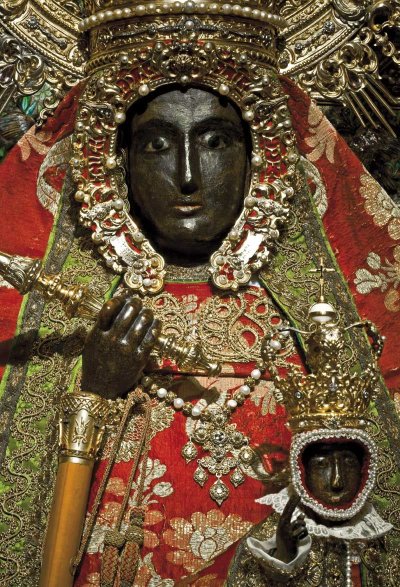 The story of the Shrine of Our Lady of Guadalupe in Extremadura, Spain falls in the same period of Spanish history as that of Covadonga.
When Don Rodrigo, the leader of the Visigoths, was defeated by the Moors in 711 and his people fled to the mountains, some of the knights
on their way to Asturia took with them a statue of the Blessed Virgin. This statue, which had been given to St. Leander, Bishop of Seville
by Pope St. Gregory the Great, was cherished not only by the people of Seville and their saintly Bishop, but it had special significance
in that it came from the Pope himself and was one of those ancient images believed to have been the work of the Evangelist St. Luke.
Some say the it was one of those images which St. Gregory carried in the famous processions held in Rome, in order to plead for the end
of the plague.
The story of the Shrine of Our Lady of Guadalupe in Extremadura, Spain falls in the same period of Spanish history as that of Covadonga.
When Don Rodrigo, the leader of the Visigoths, was defeated by the Moors in 711 and his people fled to the mountains, some of the knights
on their way to Asturia took with them a statue of the Blessed Virgin. This statue, which had been given to St. Leander, Bishop of Seville
by Pope St. Gregory the Great, was cherished not only by the people of Seville and their saintly Bishop, but it had special significance
in that it came from the Pope himself and was one of those ancient images believed to have been the work of the Evangelist St. Luke.
Some say the it was one of those images which St. Gregory carried in the famous processions held in Rome, in order to plead for the end
of the plague.
The armies of the Moors seemed invincible, nevertheless the defending Christians, heedless of their own lives, fought on during their retreat;
but they were very much concerned over such treasures as the image of Our Lady. Faced with the threat of annihilation, they wanted to secure
the statue. So they placed it in an iron casket and buried it somewhere in a cave of the Province of Extremadura, close to the Asturian
mountains in the northern part of Spain.
Those who carried the image to safety died in battle and through the centuries no one was aware that an image of the Madonna,
cherished by a great Pope and a great Bishop of Seville, was buried somewhere in the soil of Spain. Meanwhile, the Moorish rule established
itself on the Iberian peninsula. Christianity was not totally suppressed but was subjected to much hardship. Moors, Visigoths, and Hispanic
tribes mixed and created a unique cultural pattern under Islamic rule. The forces of Western Christianity, however, were on the move; the cities
of Spain were recaptured one by one and the country was liberated – the Moorish rule having lasted over four hundred years in Spain.
After the re-conquest (La Reconquista), the country did not forget the promises made by its leaders to the Blessed Virgin Mary.
Great pilgrimages visited the sanctuaries of Covadonga, Zaragoza, and many others. Devotion to the Madonna grew in intensity with each passing year.
Anything that was connected with Her had the greatest significance and this enthusiasm did not wane with the passage of time.
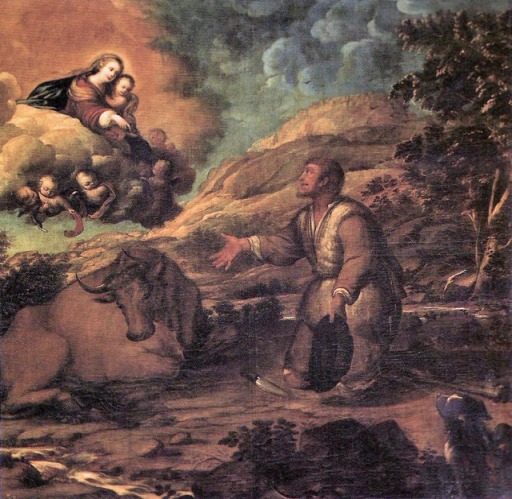 In 1326, Spain was already an established power, but not yet entirely liberated from the Moors. Still the whole nation lived literally under the
protection of Our Lady because She became part of the nation's and everybody's life. It is quite understandable that in that year, when a humble
cowherd named Gil Cordero, from Cáceres in Extremadura, reported that Our Lady had manifested Herself to him, the announcement evoked great emotion.
He claimed that Our Lady had told him to “
In 1326, Spain was already an established power, but not yet entirely liberated from the Moors. Still the whole nation lived literally under the
protection of Our Lady because She became part of the nation's and everybody's life. It is quite understandable that in that year, when a humble
cowherd named Gil Cordero, from Cáceres in Extremadura, reported that Our Lady had manifested Herself to him, the announcement evoked great emotion.
He claimed that Our Lady had told him to “...go to your land and tell the clergy and the people to come here to the place where I have appeared;
tell them to dig here and they will find an image of Me.
When ecclesiastical authorities reached the little village of Guadalupe in the
neighborhood where the casket had been unearthed, they discovered that it contained a statue which had been concealed six hundred years before
by the Knights of Don Rodrigo during their flight. The casket also contained pertinent documents which vouchsafed for the authenticity of the image.
The statue, though buried beneath the earth for six hundred years, was perfectly preserved. It was, like so many of the very ancient statues,
of a dark color, excepting those parts where it had been painted.
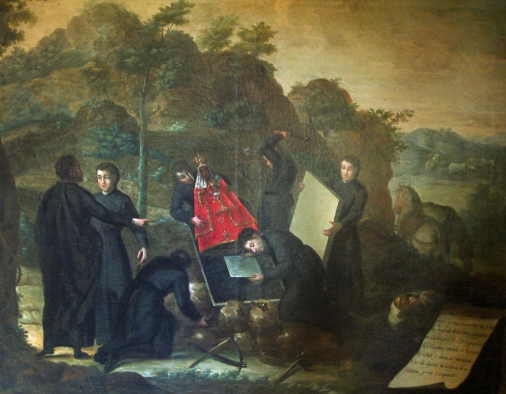 Gil Cordero had also, in the name of Mary, told the clergy:
Gil Cordero had also, in the name of Mary, told the clergy: Take Her image out (from the casket), and build Her a house...
She also told me that She would draw to Her house many people, from different parts of the world.
Faithful to Our Lady's request,
the local Spanish clergy built a makeshift structure immediately after excavation. Soon after the victorious outcome of the battle of Salado in 1340,
King Alfonso XI had a large Gothic church and monastery built in thanksgiving, in place of the provisional shrine. The Royal Monastery in Guadalupe
and its chapel are works of Moorish masons who had been converted to Christianity. The convent is one of the most interesting specimens of mixed
Moorish-Gothic art in Spain.
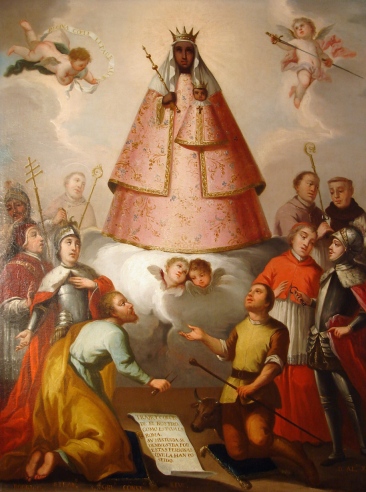 So the Shrine came into existence at Guadalupe and became one of the most important pilgrimage places of Spain. It was at the Royal
Monastery of Guadalupe that Queen Isabella and King Ferdinand thanked God and Our Lady – often called La Victoriosa – for the successful
completion of La Reconquista on January 1, 1492. There they also commissioned the expedition of Christopher Columbus, who prayed at the
Shrine of Our Lady of Guadalupe before setting out on his voyage. Cortés and Pizarro also made a pilgrimage there before their historic voyages,
as did the Franciscan Friar Zumárraga – who would become the Bishop of Mexico City – before he set out for the New World. Columbus, and later
the conquistadores, carried a replica of the image with them on their journeys, and the missionaries who accompanied these men to the newly
occupied countries, particularly Mexico, spread the veneration of the
So the Shrine came into existence at Guadalupe and became one of the most important pilgrimage places of Spain. It was at the Royal
Monastery of Guadalupe that Queen Isabella and King Ferdinand thanked God and Our Lady – often called La Victoriosa – for the successful
completion of La Reconquista on January 1, 1492. There they also commissioned the expedition of Christopher Columbus, who prayed at the
Shrine of Our Lady of Guadalupe before setting out on his voyage. Cortés and Pizarro also made a pilgrimage there before their historic voyages,
as did the Franciscan Friar Zumárraga – who would become the Bishop of Mexico City – before he set out for the New World. Columbus, and later
the conquistadores, carried a replica of the image with them on their journeys, and the missionaries who accompanied these men to the newly
occupied countries, particularly Mexico, spread the veneration of the Virgen de Guadalupe
wherever they went. This probably inspired
Bishop Zumárraga, after the apparitions on the hill of Tepeyac, to name the new Shrine in Mexico in honor of Our Lady of Guadalupe in Spain.
The new Guadalupe in Mexico was eventually to surpass its prototype in importance and renown.
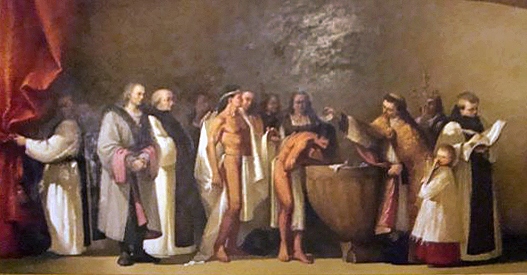 Columbus would return to the Spanish Guadalupe with the first Native American converts he had brought back from the New World,
so that they could be baptized under Our Lady's patronage. When Cortés returned from the New World, he spent nine days at the Shrine of
Extremadura in prayer, thanksgiving and abundant alms for the poor.
Columbus would return to the Spanish Guadalupe with the first Native American converts he had brought back from the New World,
so that they could be baptized under Our Lady's patronage. When Cortés returned from the New World, he spent nine days at the Shrine of
Extremadura in prayer, thanksgiving and abundant alms for the poor.
The Shrine of Our Lady of Guadalupe in Spain has distinctive mixed Moorish and Spanish characteristics. It is interesting to note that the
name Guadalupe – where the casket and the image had been found – is also a mixed Arab-Latin word meaning River of the Wolf;
for Extremadura for centuries – particularly during the Middle Ages – was infested with wolves. During the Moorish rule, the place had been
called Wadi'l-lubb. The first part of the name, Wadi, is an Arab word for river or valley; the second part is said to come
from the Latin lupus (wolf).
The statue of Our Lady of Guadalupe was canonically crowned by Pope Pius XI on October 12, 1928, during a ceremony attended
by King Alfonso XIII. In 1955 Pope Pius XII declared the church of the Royal Monastery to be a Minor Papal Basilica.
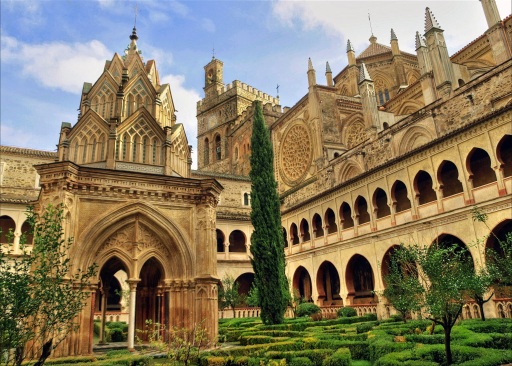
Back to "In this Issue"
Back to Top
Alphabetical Index; Calendar List of Saints
Contact us: smr@salvemariaregina.info
Visit also: www.marienfried.com


 The story of the Shrine of Our Lady of Guadalupe in Extremadura, Spain falls in the same period of Spanish history as that of Covadonga.
When Don Rodrigo, the leader of the Visigoths, was defeated by the Moors in 711 and his people fled to the mountains, some of the knights
on their way to Asturia took with them a statue of the Blessed Virgin. This statue, which had been given to St. Leander, Bishop of Seville
by Pope St. Gregory the Great, was cherished not only by the people of Seville and their saintly Bishop, but it had special significance
in that it came from the Pope himself and was one of those ancient images believed to have been the work of the Evangelist St. Luke.
Some say the it was one of those images which St. Gregory carried in the famous processions held in Rome, in order to plead for the end
of the plague.
The story of the Shrine of Our Lady of Guadalupe in Extremadura, Spain falls in the same period of Spanish history as that of Covadonga.
When Don Rodrigo, the leader of the Visigoths, was defeated by the Moors in 711 and his people fled to the mountains, some of the knights
on their way to Asturia took with them a statue of the Blessed Virgin. This statue, which had been given to St. Leander, Bishop of Seville
by Pope St. Gregory the Great, was cherished not only by the people of Seville and their saintly Bishop, but it had special significance
in that it came from the Pope himself and was one of those ancient images believed to have been the work of the Evangelist St. Luke.
Some say the it was one of those images which St. Gregory carried in the famous processions held in Rome, in order to plead for the end
of the plague. In 1326, Spain was already an established power, but not yet entirely liberated from the Moors. Still the whole nation lived literally under the
protection of Our Lady because She became part of the nation's and everybody's life. It is quite understandable that in that year, when a humble
cowherd named Gil Cordero, from Cáceres in Extremadura, reported that Our Lady had manifested Herself to him, the announcement evoked great emotion.
He claimed that Our Lady had told him to “
In 1326, Spain was already an established power, but not yet entirely liberated from the Moors. Still the whole nation lived literally under the
protection of Our Lady because She became part of the nation's and everybody's life. It is quite understandable that in that year, when a humble
cowherd named Gil Cordero, from Cáceres in Extremadura, reported that Our Lady had manifested Herself to him, the announcement evoked great emotion.
He claimed that Our Lady had told him to “ Gil Cordero had also, in the name of Mary, told the clergy:
Gil Cordero had also, in the name of Mary, told the clergy:  So the Shrine came into existence at Guadalupe and became one of the most important pilgrimage places of Spain. It was at the Royal
Monastery of Guadalupe that Queen Isabella and King Ferdinand thanked God and Our Lady – often called La Victoriosa – for the successful
completion of La Reconquista on January 1, 1492. There they also commissioned the expedition of Christopher Columbus, who prayed at the
Shrine of Our Lady of Guadalupe before setting out on his voyage. Cortés and Pizarro also made a pilgrimage there before their historic voyages,
as did the Franciscan Friar Zumárraga – who would become the Bishop of Mexico City – before he set out for the New World. Columbus, and later
the conquistadores, carried a replica of the image with them on their journeys, and the missionaries who accompanied these men to the newly
occupied countries, particularly Mexico, spread the veneration of the
So the Shrine came into existence at Guadalupe and became one of the most important pilgrimage places of Spain. It was at the Royal
Monastery of Guadalupe that Queen Isabella and King Ferdinand thanked God and Our Lady – often called La Victoriosa – for the successful
completion of La Reconquista on January 1, 1492. There they also commissioned the expedition of Christopher Columbus, who prayed at the
Shrine of Our Lady of Guadalupe before setting out on his voyage. Cortés and Pizarro also made a pilgrimage there before their historic voyages,
as did the Franciscan Friar Zumárraga – who would become the Bishop of Mexico City – before he set out for the New World. Columbus, and later
the conquistadores, carried a replica of the image with them on their journeys, and the missionaries who accompanied these men to the newly
occupied countries, particularly Mexico, spread the veneration of the  Columbus would return to the Spanish Guadalupe with the first Native American converts he had brought back from the New World,
so that they could be baptized under Our Lady's patronage. When Cortés returned from the New World, he spent nine days at the Shrine of
Extremadura in prayer, thanksgiving and abundant alms for the poor.
Columbus would return to the Spanish Guadalupe with the first Native American converts he had brought back from the New World,
so that they could be baptized under Our Lady's patronage. When Cortés returned from the New World, he spent nine days at the Shrine of
Extremadura in prayer, thanksgiving and abundant alms for the poor.
